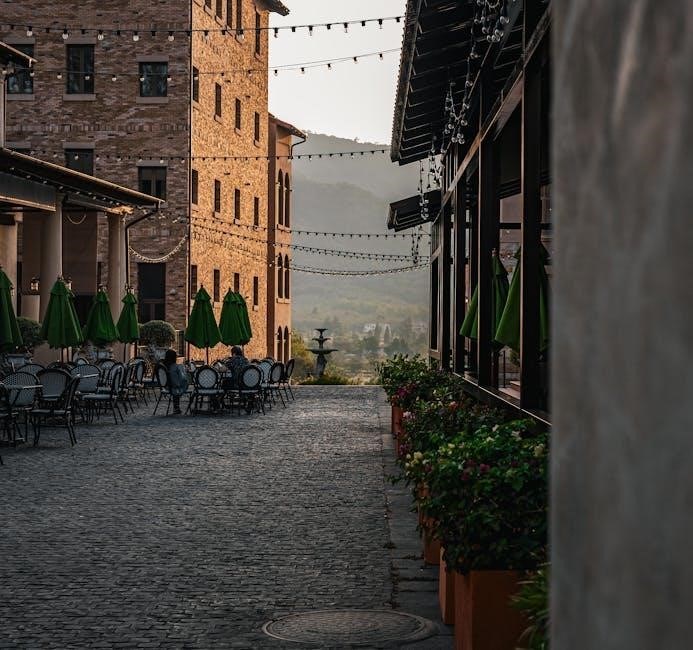Ancient remedies are time-tested practices offering holistic health solutions, blending herbs, rituals, and natural elements․ Their resurgence in modern times highlights their relevance for stress relief, immunity, and well-being․
1․1 Definition and Historical Context
Ancient remedies refer to traditional healing practices and natural treatments rooted in centuries-old wisdom․ Originating from civilizations like China, India, and Persia, these methods emphasize holistic health, combining herbs, rituals, and lifestyle practices․ Historical records, such as Traditional Chinese Medicine (TCM) texts and Ayurvedic scriptures, document their evolution․ These remedies often focus on balancing energies, like TCM’s “qi” or Ayurveda’s “doshas,” to restore well-being․ Persian physicians also contributed significantly, with medieval texts detailing effective pain relief treatments․ These practices, passed through generations, form the foundation of natural health, offering sustainable solutions for modern challenges․ Their historical context highlights humanity’s enduring quest for harmony with nature and health․
1․2 Importance of Ancient Remedies in Modern Times
Ancient remedies are gaining traction in modern times due to their natural, holistic approach to health․ With increasing interest in wellness and sustainability, people are turning to these time-tested methods for stress relief, immunity, and energy․ Modern science validates many traditional practices, such as TCM and Ayurveda, bridging ancient wisdom with contemporary needs․ These remedies offer accessible, cost-effective solutions for chronic issues, aligning with today’s focus on preventive care․ Their integration into modern lifestyles highlights their enduring relevance, making them a valuable complement to conventional medicine․ Ancient remedies empower individuals to take charge of their health naturally, fostering a balanced and sustainable approach to well-being․
Traditional Chinese Medicine (TCM)
TCM is a cornerstone of ancient remedies, emphasizing harmony between body and nature․ Its holistic approach, including herbalism and acupuncture, is now widely studied and practiced globally․
2․1 Overview of TCM Principles
Traditional Chinese Medicine (TCM) is rooted in ancient philosophies like Yin-Yang and the Five Elements․ It views the body as a microcosm of the universe, emphasizing harmony and balance․ TCM principles focus on the flow of Qi (vital energy) through meridians, which are pathways connecting organs․ Health is achieved when Qi circulates freely, while blockages lead to illness․ TCM also incorporates the concept of TCM syndromes, which are patterns of disharmony․ Treatments aim to restore equilibrium, often through acupuncture, herbal remedies, and dietary adjustments․ This holistic approach has made TCM a cornerstone of natural healing, now integrated into modern wellness practices worldwide․
2․2 Popular TCM Remedies and Their Benefits
Traditional Chinese Medicine (TCM) offers a variety of remedies, each with unique benefits․ Ginseng, for instance, is renowned for boosting energy and vitality, while licorice root aids digestion and soothes respiratory issues․ Acupuncture is widely practiced to relieve pain and improve circulation․ Herbal formulas like Shuanghuanglian are used to combat colds and flu․ These remedies are not only effective but also align with TCM’s holistic approach, promoting overall well-being․ Modern studies validate their efficacy, making them popular choices for natural health enthusiasts seeking alternatives to conventional treatments․
2․3 Role of Herbalism in TCM
Herbalism is a cornerstone of Traditional Chinese Medicine (TCM), emphasizing the use of natural plants to restore balance and harmony in the body․ TCM herbal remedies are tailored to individual needs, addressing specific energy imbalances․ Ginseng, licorice root, and astragalus are popular herbs known for their adaptogenic properties, boosting vitality and immune function․ Herbal formulas often combine multiple ingredients to enhance efficacy and minimize side effects․ These remedies are not only used for treatment but also for prevention, aligning with TCM’s holistic approach․ Modern research continues to validate the benefits of TCM herbalism, making it a sought-after natural health solution worldwide․

Ayurveda: Ancient Indian Healing
Ayurveda is an ancient Indian system promoting natural health through herbs, rituals, and mind-body balance․ Its holistic approach is gaining global recognition for chronic wellness solutions․
3․1 Core Concepts of Ayurveda
Ayurveda, an ancient Indian healing system, revolves around the concept of three doshas—Vata, Pitta, and Kapha—that govern the body․ It emphasizes harmony between mind, body, and nature․ Practices like turmeric, ashwagandha, and triphala are central, offering holistic wellness solutions․ The doshas determine individual health profiles, guiding personalized remedies․ Modern studies validate these practices, making Ayurvedic principles accessible globally․ Ancient remedies PDFs provide detailed insights into these core concepts, enabling individuals to explore natural healing methods effectively․
3․2 Key Herbs and Practices in Ayurveda
Ayurveda relies on key herbs like turmeric, ashwagandha, and triphala, known for their healing properties․ Turmeric aids in inflammation reduction, while ashwagandha boosts energy and mental clarity․ Triphala supports digestion and detoxification․ Practices such as meditation, yoga, and Panchakarma detoxification are integral to Ayurvedic routines․ These methods aim to balance the doshas and promote overall well-being․ Ancient remedies PDFs detail these herbs and practices, offering insights into their preparation and application․ By following these traditions, individuals can adopt natural, holistic approaches to health, aligning with Ayurveda’s timeless wisdom․
3․3 Modern Recognition of Ayurvedic Remedies
Ayurvedic remedies are gaining global recognition for their health benefits, with practices like turmeric, ashwagandha, and triphala now backed by scientific studies․ These ancient herbs are celebrated for their anti-inflammatory, stress-relieving, and immune-boosting properties․ Modern society increasingly embraces Ayurveda as a holistic approach to wellness, integrating it into daily routines․ Ancient remedies PDFs highlight these traditions, making them accessible to a broader audience․ As people seek natural alternatives, Ayurveda’s timeless wisdom is being rediscovered, offering solutions for modern health challenges while preserving its cultural heritage․

Ancient Persian Remedies
Ancient Persian medicine, documented by physicians, offers effective pain relief remedies validated by modern studies, showcasing their enduring relevance in natural health and wellness practices today․
4․1 Contributions of Persian Physicians
Persian physicians made significant contributions to ancient remedies, documenting effective treatments in medieval texts․ Their work emphasized herbalism and natural healing, influencing modern medicine․ Avicenna’s The Canon of Medicine remains a cornerstone, detailing remedies for pain and inflammation․ These physicians also explored mental health, linking stress to physical ailments․ Their holistic approach, combining diet, lifestyle, and herbs, is now validated by scientific studies․ Ancient Persian remedies, such as saffron for mood enhancement, are gaining recognition globally․ Their legacy underscores the importance of natural healing, offering timeless solutions for contemporary health challenges․ These contributions highlight the enduring relevance of Persian medical wisdom in today’s world․
4․2 Effective Pain Relief Remedies from Persian Medicine
Persian Medicine offers a wealth of effective pain relief remedies, rooted in centuries of empirical knowledge․ Herbs like willow bark, containing salicylic acid, and myrrh, known for its anti-inflammatory properties, were widely used․ These natural remedies were often combined with therapeutic techniques such as heat therapy and massage․ Persian physicians documented these methods in detailed texts, which modern studies have validated․ Their holistic approach to pain management emphasized treating the root cause rather than just symptoms․ Today, these ancient remedies continue to provide relief for various types of pain, showcasing the enduring wisdom of Persian Medicine in addressing human health challenges․

Herbal Medicine in Ancient Cultures
Ancient cultures harnessed herbs for their versatility in healing, from treating ailments to enhancing well-being․ Their use spanned across civilizations, shaping traditional remedies still valued today․
5․1 Role of Herbs in Traditional Healing
Herbs have played a central role in traditional healing across ancient cultures, offering natural solutions for various ailments․ From turmeric to ashwagandha, these plants were valued for their medicinal properties and holistic benefits․ Many traditional systems, like TCM and Ayurveda, relied on herbs to restore balance and promote well-being․ Their versatility allowed them to be used in teas, tinctures, and topical treatments, making them accessible for everyday health․ Modern science has validated the efficacy of many ancient herbs, bridging the gap between traditional practices and contemporary healthcare․ This resurgence highlights the enduring relevance of herbal medicine in fostering health and vitality․

5․2 Common Herbs Used Across Ancient Civilizations
Ancient civilizations utilized a variety of herbs for their medicinal and therapeutic properties․ Turmeric, known for its anti-inflammatory benefits, was a staple in Ayurvedic practices․ Ginseng, revered in Traditional Chinese Medicine, was used to boost energy and vitality․ Ashwagandha, another Ayurvedic herb, was prized for its adaptogenic qualities, helping to reduce stress․ Similarly, Persian medicine highlighted the use of saffron and chamomile for their calming effects․ These herbs, along with others like ginger and garlic, were common across cultures, showcasing a shared understanding of their health benefits․ Their widespread use underscores the interconnectedness of ancient healing traditions and their enduring relevance today․
Ancient Superfoods and Their Benefits
Ancient superfoods like maca, spirulina, and chia seeds have been used for centuries to enhance vitality and improve health, offering natural solutions for modern wellness needs․

6․1 Definition and Examples of Ancient Superfoods
Ancient superfoods are nutrient-dense foods revered for their health benefits, often used in traditional remedies․ Examples include maca, spirulina, and chia seeds, consumed by ancient civilizations like the Incas and Aztecs․ Turmeric, ginger, and goji berries are also prominent, featured in Ayurvedic and TCM practices․ These foods were valued for their ability to boost energy, enhance immunity, and promote overall well-being․ Many ancient remedies PDFs highlight these superfoods, detailing their historical use and modern applications․ They remain popular today for their natural, holistic approach to health, offering a bridge between ancient wisdom and contemporary wellness practices․
6․2 How Superfoods Boost Energy and Immunity
Ancient superfoods are renowned for their ability to enhance energy levels and strengthen immunity․ Foods like maca, spirulina, and goji berries are rich in vitamins, minerals, and antioxidants that combat fatigue and support immune function․ Turmeric and ginger, commonly used in Ayurvedic remedies, reduce inflammation and boost vitality․ These superfoods work by nourishing the body at a cellular level, promoting long-term health․ Many ancient remedies PDFs detail their use in traditional healing, offering natural solutions to modern health challenges․ By incorporating these superfoods into daily routines, individuals can harness their ancient wisdom to maintain energy and resilience in today’s fast-paced world․

Ancient Remedies for Stress and Burnout
Ancient remedies offer natural techniques to alleviate stress and burnout, such as Ayurvedic herbs, TCM practices, and holistic rituals that promote mental and physical balance effectively․
7․1 Natural Stress-Relief Techniques from Ancient Times
Ancient cultures developed effective natural stress-relief methods, such as Ayurvedic meditation, yoga, and breathing exercises․ Traditional Chinese Medicine (TCM) emphasizes acupuncture and herbal teas to calm the mind․ Persian medicine highlights aromatherapy with saffron and rosewater for relaxation․ These practices, rooted in holistic healing, focus on balancing body and mind․ They offer sustainable solutions to modern stress, promoting long-term well-being without harmful side effects․ By revisiting these ancient techniques, individuals can adopt natural, non-invasive ways to manage stress and improve mental health․ These methods are now widely recognized for their efficacy and are often recommended alongside modern therapies․
7․2 Ancient Practices for Reducing Burnout
Ancient traditions offer timeless solutions to combat burnout, emphasizing holistic approaches to restore balance․ Ayurveda recommends detoxification rituals like panchakarma to rejuvenate the body and mind․ Traditional Chinese Medicine (TCM) suggests acupuncture and tai chi to harmonize energy flow․ Persian medicine advocates for herbal remedies like saffron and chamomile to uplift mood and reduce fatigue․ These practices focus on addressing the root causes of burnout, promoting mental clarity and physical renewal․ By integrating these ancient techniques, individuals can achieve sustainable well-being and resilience against modern stressors․ These methods are now being embraced as natural complements to contemporary burnout solutions․
Modern Relevance of Ancient Remedies
Ancient remedies are gaining traction in contemporary healthcare, offering natural solutions to modern ailments; Their integration into today’s wellness practices highlights their enduring value and scientific validation․
8;1 Scientific Validation of Ancient Remedies
Modern science increasingly validates ancient remedies, confirming their efficacy through rigorous studies․ Traditional Chinese Medicine (TCM) and Ayurveda, for instance, have seen their herbal remedies scientifically proven to enhance immunity and reduce inflammation․ Turmeric, ashwagandha, and ginger, once dismissed as mere folklore, are now backed by clinical trials․ Similarly, Persian remedies, such as saffron and rosewater, have shown promise in pain relief and mental health․ These validations bridge the gap between traditional practices and contemporary healthcare, offering natural alternatives to synthetic drugs․ As research expands, ancient remedies are gaining recognition as complementary therapies, reshaping modern medicine’s approach to holistic well-being․

8․2 Integration of Ancient Remedies into Modern Healthcare
Ancient remedies are increasingly being integrated into modern healthcare, offering a holistic approach to treatment․ Hospitals and clinics now incorporate traditional practices like acupuncture, herbal therapies, and Ayurvedic massages․ The rise of herbal drug development, inspired by ancient Persian and Chinese medicine, is transforming pharmacology․ Modern healthcare professionals collaborate with traditional healers to create hybrid treatments, blending natural remedies with conventional medicine․ This integration not only addresses physical ailments but also emphasizes mental and emotional well-being, aligning with the growing demand for preventative and holistic care․ As a result, ancient remedies are becoming a vital part of contemporary healthcare systems worldwide․

How to Access Ancient Remedies PDFs for Free
Access ancient remedies PDFs through trusted sources like universities, cultural websites, and open-access libraries․ Verify authenticity and reliability before downloading to ensure safe and accurate information․
9․1 Trusted Sources for Downloading Ancient Remedies PDFs
Trusted sources for ancient remedies PDFs include academic platforms like Google Scholar, ResearchGate, and university repositories․ Cultural heritage websites and open-access libraries also offer authentic downloads․ Platforms like Archive․org host historical texts, while reputable publishers provide free e-books on traditional medicine․ Always verify the credibility of the source and check for peer-reviewed or historically validated content․ Be cautious of unofficial sites to avoid misinformation․ Prioritize sources with clear citations and references to ensure the material is genuine and scientifically backed․ This approach guarantees safe and reliable access to ancient remedies PDFs for educational and personal use․
9․2 Tips for Finding Reliable and Free Resources
When searching for ancient remedies PDFs, prioritize academic and cultural heritage websites․ Use specific keywords like “traditional medicine” or “herbalism” to refine searches․ Check platforms like Google Scholar, ResearchGate, and open-access libraries for peer-reviewed content․ Verify the credibility of sources by looking for historical validation or institutional affiliations․ Avoid unofficial sites that may offer unverified information․ Utilize filters for free access on academic databases and explore repositories like Project Gutenberg for historical texts․ Always review the content for accuracy and relevance before downloading․ By following these steps, you can efficiently locate reliable and free resources on ancient remedies․
Safety and Precautions
Always consult healthcare professionals before using ancient remedies․ Ensure ingredients are safe and suitable for your health conditions to avoid adverse reactions or interactions with medications․
10․1 Potential Risks of Using Ancient Remedies
Ancient remedies, while natural, can pose risks․ Allergic reactions, incorrect dosages, or interactions with modern medications may occur․ Some herbs, though beneficial, can be toxic in excess․ Additionally, lack of standardization in preparation and sourcing increases safety concerns․ Pregnant individuals or those with chronic conditions should exercise caution․ Modern studies validate some remedies, but improper use can lead to adverse effects․ Consulting healthcare professionals is crucial to mitigate risks and ensure safe application of these traditional practices․
10․2 Importance of Consulting Healthcare Professionals
Consulting healthcare professionals is essential when exploring ancient remedies․ They provide personalized advice, ensuring safe use and avoiding harmful interactions with modern treatments․ Experts can guide proper dosages and identify potential risks, especially for vulnerable groups like pregnant individuals or those with chronic conditions․ Their knowledge bridges traditional practices with modern medicine, optimizing benefits while minimizing risks․ This collaborative approach fosters a holistic health strategy, respecting both ancient wisdom and contemporary medical advancements․ Seeking professional advice ensures that natural remedies enhance, rather than compromise, overall well-being․
Ancient remedies offer timeless wisdom for modern health challenges, blending natural healing with cultural traditions․ Exploring these practices responsibly can enhance well-being, supported by accessible resources like free PDF guides․

11․1 Summary of Key Points
Ancient remedies, spanning TCM, Ayurveda, and Persian medicine, offer holistic health solutions․ These practices emphasize natural healing through herbs, rituals, and superfoods, addressing modern ailments like stress and burnout․ Their effectiveness, validated by science, integrates seamlessly into contemporary healthcare․ Resources like free PDF guides provide accessible knowledge, enabling individuals to explore these traditions responsibly․ By embracing ancient wisdom, one can enhance well-being, boost immunity, and adopt sustainable lifestyle practices․ These remedies not only heal the body but also align with the mind and spirit, fostering a balanced approach to health․ Their timeless relevance continues to inspire global wellness journeys․
11․2 Encouragement to Explore Ancient Remedies
Exploring ancient remedies offers a gateway to timeless wisdom, empowering individuals to take charge of their health naturally․ With free PDF resources readily available, anyone can discover the benefits of TCM, Ayurveda, and Persian medicine․ These traditions provide holistic approaches to wellness, addressing both physical and mental health; By incorporating ancient superfoods, herbs, and stress-relief techniques, one can enhance energy, immunity, and overall well-being․ Embracing these practices fosters a deeper connection to nature and heritage, promoting a balanced lifestyle․ Start your journey today and experience the transformative power of ancient remedies for a healthier, more vibrant life․
Call to Action
Download ancient remedies PDFs for free and embark on a journey of natural healing․ Discover timeless wisdom to boost your health and wellness effortlessly today!
12․1 Download Ancient Remedies PDFs Responsibly
Downloading ancient remedies PDFs for free can be a great way to access timeless health wisdom․ Ensure you use trusted sources to avoid illegal or unsafe content․ Verify the credibility of websites and avoid those offering pirated material․ Many reputable platforms provide free resources, such as academic journals or traditional medicine websites․ Always check for reviews or recommendations before downloading․ Additionally, be cautious of files that may contain malware․ Prioritize sources that respect intellectual property and support the preservation of ancient knowledge․ By downloading responsibly, you contribute to the ethical sharing of these valuable resources while safeguarding your device and personal information․
12․2 Start Your Journey with Natural Healing
Embark on a transformative journey with ancient remedies by exploring free PDF resources․ These guides offer insights into natural healing practices, from herbalism to stress-relief techniques․ Discover how to incorporate time-tested methods into your daily routine for improved well-being․ Begin by exploring traditional Chinese medicine or Ayurvedic principles, and learn how superfoods can boost your energy and immunity․ Start small by trying simple remedies or practices, and gradually adopt more complex techniques․ Remember to consult healthcare professionals before making significant changes․ By embracing these ancient wisdoms, you can take the first steps toward a healthier, more balanced lifestyle, empowered by nature’s healing power․
